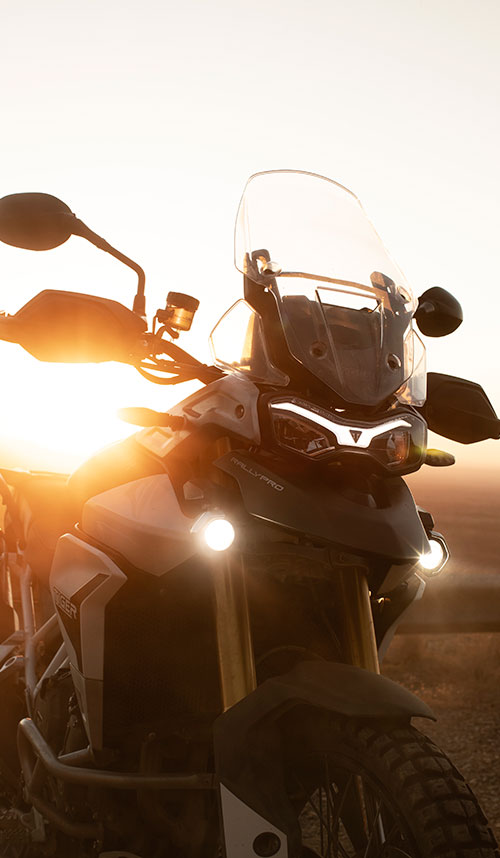Tiger 900 series: What do the GT and Rally offer?
Triumph’s gutsy decision to replace the 800 with the all-new 900 series might just do the trick.

Author – Ritin Paul
Intro: We are familiar with the Tiger 800, what Triumph has done here is that it has replaced an already successful model (in this case the Tiger 800) and has it replaced with the new 900 GT Pro and Rally Pro. The Tiger 800 already had a fan following creating a cult status, especially for Triumph lovers. The 900 then will take the responsibility of taking up the pedestal and aiming for glory nothing short of what the 800 achieved. We have learned that the 900 shares no resemblance to the 800, meaning everything on the 900 series are brand new. It is a welcome move by Triumph as the 800 began to show its age despite timely upgradations. It follows standard nomenclature namely the – GT or the Rally, the Pro suffix indicates it is a top trim variant. The GT then is the road based variant and the Rally is an off-road based variant.

First impressions: The GT Pro, as already mentioned has a low ride height; the cast alloy wheels mark a strong impression. The GT Pro gets an all-new suspension – Marzocchi suspension and an electronically adjustable gas-charged mono-shock. The Rally is fully adjustable with a long travel Showa suspension. The Rally has higher ground clearance, and it gets a bigger front wheel. It comes equipped with tubeless wire-spoke rims something that was missing on the 800 range. Both the Rally and the GT share the same frame, body panels, 7.0 inch TFT display, and the latest in-line triple engine. In a nutshell, the 900 series is a welcome refresh and will certainly lift spirits who are on the lookout for an adventure motorcycle. For instance, the sleek pair of LED headlamps with an integrated LED unit above gives an aggressive outlook. The tall and easy to adjust windscreen is nicely mounted on the top. All this gives proper adventure bike looks making it look striking, add to that a beak which completes the neat look.


On the side, the cleverly designed fuel tank which looks narrower has a 20-liter capacity. The split radiator sits on either side of the motorcycle and looks fascinating with the well-designed shroud covering the fans. Another notable change is the new set of repositioned and improved LED indicators which sits well adjacent to the headlamp. The design at the rear is simplistic, there are no body panels. You will find a plastic extension that houses the new horizontal tail lamp. It incorporates a new identity; a notable change from the 800 is that the 900 comes with a lightweight aluminum subframe that is bolted to the new frame. It means if at all there is an accident, it becomes cost-effective to replace the damages. The seats despite its slim profile feel comfy and can be manually lowered by 20mm in 2-3 minutes; the handlebar can also be moved 10mm closer to the rider. The quality of materials is top-notch.
Engine: The Tiger 900’s new in-line triple motor is the talk of the town, rightly so, because the motor sounds so incredible. This one feels so much better over the outgoing 800 which was a great thumping motor too. The firing order and the T plane crank had much to do with the mesmerizing sound in the motor of the 900 series. What one can hear is a powerful grunt at low and mid-range and also a sense of urgency which will not take much time getting used to. Thanks to its strong bottom end you can engage in 4th gear even while moving at 30-40 km/h. On the open road, you can go up till 200 km/h without the need to downshift. It goes on to show the strong mid-range of the motor. However, vibrations in the handlebar are a point of botheration at hard acceleration. This is an ideal machine for highway cruising, you can easily clock in 100-120 km/h speeds with the engine revving between 4000-5000 rpm suggesting how good the mid-range is. The quick shifter ensures maneuvering tricky spots is hassle-free. Things like traction control, IMU, and the option to choose a riding mode to ensure the bike will take you through most rough patches. Available modes include – Road, Rain, Sport, Off-Road, and Rider which alter the level of traction and ABS intervention. The off-road mode, when engaged in the GT Pro, will help you tackle light trails, on the Rally Pro, the off-road mode turns ABS and traction control off, meaning you can drift through challenging terrains with ease.

Mannerism: Apart from the lighter chassis, Triumph has also made the engine lighter. The better weight distribution along with the new suspension units pour out feelings of improved ride and mannerism. The GT Pro’s Marzocchis suspension did a brilliant job of soaking up bumps. The front end is better than before and you will notice that it responds well while you push it hard to the point where the pegs end up grinding into the tarmac.
The Rally Pro is a delight to zoom past winding roads, it is a mature bike which behaves very well on-road and off-road. That being said, it is off-road where the Rally Pro feels best, the perfectly set up suspension, chassis balance, and peppy motor makes this adventure bike a delight to ride while off-road. The new Brembo Stylema brakes add to the confidence in maneuvering this bike off-road.

Should you have one: Both variants on offer look very promising. The major takeaway is the peppy engine which feels great to hear. The new suspension setup and better weight distribution see to it that the Tiger 900 feels and rides better than the 800. And, with the long equipment list – the GT which is priced at Rs. 13.7 lakh and the Rally which is priced at Rs. 14.35 lakh seems very competitive.






